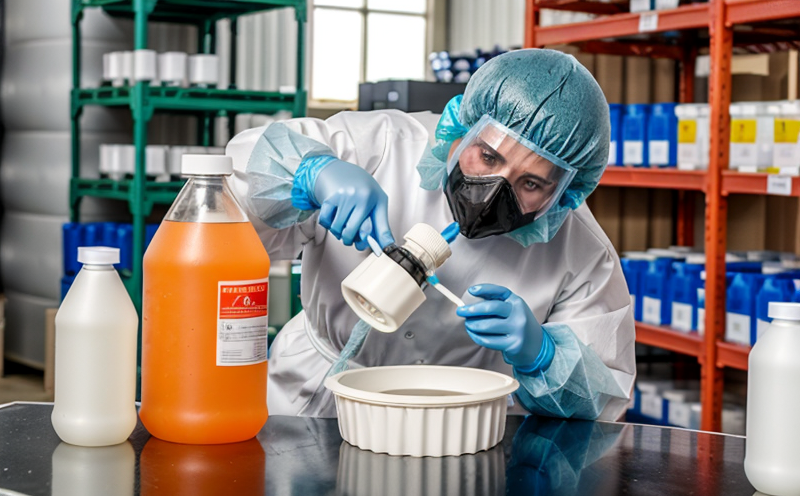OECD Validation of Microbiological Methods in Packaging Testing
The OECD (Organisation for Economic Co-operation and Development) guidelines play a pivotal role in ensuring that scientific research is conducted to high standards. These guidelines provide a robust framework for validating microbiological methods used in packaging materials testing, which helps ensure the safety and integrity of packaged goods.
Microbiological safety testing in packaging materials aims at identifying potential contamination risks that could compromise product quality or pose health hazards. By validating these methods according to OECD standards, laboratories can provide reliable data that contributes significantly to regulatory compliance and consumer confidence.
The process involves a series of steps designed to evaluate the performance characteristics of microbiological tests intended for use in packaging materials testing. This includes assessing sensitivity, specificity, reproducibility, and robustness under various conditions relevant to real-world scenarios. The ultimate goal is to ensure that these methods are both effective and accurate when applied during routine quality control checks.
One key aspect of this validation process lies in understanding how different environmental factors might affect the results obtained from microbiological tests conducted on packaging materials. Factors such as temperature, humidity levels, pH balance, and storage duration can all impact bacterial growth rates or other relevant indicators being measured by these tests. Therefore, it's essential to standardize testing protocols so that they account for such variations appropriately.
Another critical consideration is ensuring compatibility between the chosen microbiological method(s) and existing packaging materials specifications. For instance, if a particular type of plastic film has specific chemical properties or additives incorporated into its composition, those must be taken into account when selecting an appropriate testing technique. Similarly, any pre-treatment steps required before conducting actual tests should align with industry best practices.
Given the complexity involved in validating microbiological methods for packaging materials testing according to OECD guidelines, it becomes necessary to employ advanced analytical instruments capable of detecting even trace amounts of microorganisms present within samples. These tools typically include scanning electron microscopy (SEM), flow cytometry, or high-performance liquid chromatography (HPLC) systems among others.
Once the validation process is completed successfully, laboratories can issue reports detailing all relevant findings along with recommendations for improvement where applicable. Such documentation serves as a valuable resource not only for internal reference but also during external audits conducted by regulatory authorities like FDA or EU Commission.
In summary, validating microbiological methods according to OECD guidelines ensures that packaging materials undergo rigorous scrutiny aimed at identifying any potential risks associated with microbial contamination early on in the product lifecycle. This approach promotes safer products while enhancing overall trustworthiness within supply chains globally.
Applied Standards
| Standard Number | Description |
|---|---|
| OECD 104 | Validation of microbiological methods used in the assessment of packaging materials and articles |
| ISO 28962-5 | Biological safety - Packaging and packaging systems -- Part 5: Microbiological properties |
| ASTM E1743 | Standard guide for selection, application, and validation of microbiological methods for the examination of packages containing food or nonfood products |
Scope and Methodology
The scope of this service encompasses the entire lifecycle of validating microbiological methods used in packaging materials testing, following OECD guidelines. This includes:
- Reviewing existing literature on relevant microbiological techniques.
- Selecting appropriate specimens based on target applications.
- Establishing baseline conditions under which tests will be conducted.
- Conducting initial trials to assess method performance against defined criteria.
- Refining methods as needed based on trial outcomes until they meet all specified requirements.
The methodology employed during this validation process involves several key steps:
- Initial Assessment: Evaluate the necessity of conducting such a test and determine whether there exists an acceptable alternative method available commercially.
- Protocol Development: Create detailed protocols outlining all aspects of the proposed testing procedure, including sample preparation procedures, reagent concentrations, incubation times, etc.
- Trial Runs: Carry out multiple trial runs using known positive and negative controls to ensure consistent results across different batches of materials.
- Data Analysis: Analyze collected data statistically to determine whether the proposed method meets all established criteria for accuracy, precision, and reliability.
- Reporting: Prepare comprehensive reports summarizing all findings along with recommendations for further improvements if required.
Throughout this entire process, close collaboration between technical experts from both internal teams and external consultants ensures adherence to strict quality control measures at every stage. This collaborative approach guarantees that only the most reliable methods are selected for use in subsequent packaging materials testing operations.
Environmental and Sustainability Contributions
The OECD validation of microbiological methods in packaging testing has numerous environmental benefits, contributing positively towards sustainability goals. By ensuring that packaged goods remain safe throughout their shelf life, this service reduces waste generation due to spoilage or contamination issues. It also minimizes energy consumption associated with additional processing steps needed to address potential risks.
Moreover, by promoting the use of more environmentally friendly packaging materials through rigorous testing processes, we encourage manufacturers to adopt greener practices without compromising product quality. This aligns perfectly with broader sustainability initiatives aimed at reducing carbon footprints across industries worldwide.
The OECD validation process also fosters innovation within research and development departments by encouraging continuous improvement in analytical techniques. As new challenges arise regarding packaging material safety concerns, having well-established guidelines like those provided by the OECD allows scientists to quickly adapt existing methods or develop entirely novel approaches tailored specifically for these emerging issues.





